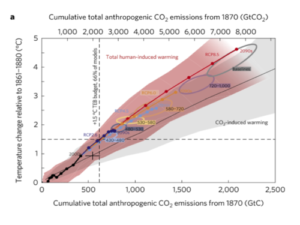by Ross McKitrick, September 26, 2017 in ClimateEtc.
A number of authors, including the IPCC, have argued that climate models have systematically overstated the rate of global warming in recent decades. A recent paper by Millar et al. (2017) presented the same finding in a diagram of temperature change versus cumulative carbon emissions since 1870.

by C. Monckton of Brenchley, September 26, 2017 in WUWT
In the climate debate, though, it pays to read the small print. Official climatology does not usually admit its many errors: instead, we are ordered to obey the “consensus”, as the Party Line is these days rebranded. On reading the headlines, I suspected at once that the true purpose of the latest admission, by Millar et al. in the current issue of Nature Geo“science”, is to minimize and thus to conceal the true magnitude of past over-predictions.
The most productive volcanic systems on Earth are hidden under an average of 8,500 feet (2,600 m) of water. Beneath the oceans a global system of mid-ocean ridges produces an estimated 75% of the annual output of magma. An estimated 0.7 cubic miles (3 cubic kilometers) of lava is erupted. The magma and lava create the edges of new oceanic plates and supply heat and chemicals to some of the Earth’s most unusual and rare ecosystems.
by Connaissance des Energies, 26 septembre 2017
Les énergies fossiles toujours omniprésentes dans le mix mondial
La consommation mondiale d’énergie primaire a encore reposé à 81,4% sur les énergies fossiles en 2015 selon les dernières données de l’AIE. En 1973, cette part atteignait 86,7% (dont 46,2% pour le seul pétrole) et les énergies décarbonées ont ainsi légèrement progressé dans le mix énergétique mondial.
Notons que les productions mondiales de gaz naturel et de charbon ont respectivement triplé et plus que doublé depuis 1973. Les émissions mondiales de CO2 relatives à la combustion d’énergie ont pour leur part doublé durant cette période.
See also here (.pdf 151 pages)
La géologie, une science plus que passionnante … et diverse

